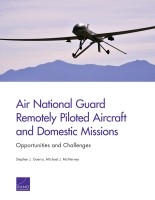| 来源类型 | Research Reports
|
| 规范类型 | 报告
|
| ISBN | 9780833091215
|
| 来源ID | RR-1016-OSD
|
| Air National Guard Remotely Piloted Aircraft and Domestic Missions: Opportunities and Challenges |
| Stephen J. Guerra; Michael J. McNerney
|
| 发表日期 | 2015
|
| 出版年 | 2015
|
| 页码 | 46
|
| 语种 | 英语
|
| 结论 |
There Are Five Types of Domestic RPA Missions - The mission types are border countermigrant, border change detection, maritime counterdrug operations, incident reconnaissance, and fixed-target surveillance.
- Given their current capabilities, ANG RPAs are best suited to incident reconnaissance and fixed-target surveillance. As the ANG introduces more MQ-9s, the force will also become capable of border change-detection missions, which rely on synthetic aperture radar.
ANG RPAs' Utility in Domestic Missions Is Affected by Several Key Policy Constraints - The Secretary of Defense must explicitly approve any operational use of DoD RPAs within the United States.
- RPA units must draft and gain approval of a Proper Use Memorandum outlining the mission, intended use of the imagery, and safeguards that will be employed to prevent unauthorized development or use of imagery.
- Operating RPAs in most unrestricted airspace requires special approval from the Federal Aviation Administration (FAA) in the form of a certificate of authorization.
- United States Code Title 10 and Title 32 offer further constraints on information sharing.
|
| 摘要 |
- The current ANG RPA force can add the most value by freeing up DHS RPAs to focus on the missions for which they are best equipped: border countermigrant, border change-detection, and maritime counterdrug missions. Consequently, decisionmakers should consider ANG RPAs for incident-reconnaissance missions and, to the extent that policy restrictions allow, fixed-target surveillance.
- The ANG should prioritize the MQ-9 conversion of units closest to the southwestern border. This would position aircraft with appropriate sensors closest to the areas where they would be best utilized, which would speed response while minimizing the need for transits to the border and thus requests for access to additional airspace.
- When conducting RPA-related exercises and training, the National Guard should include events focusing on strategic-level policy constraints and coordination with personnel from OSD and other agencies.
- The National Guard and other stakeholders should adopt procedures like those associated with the Secretary of Defense Orders Book; this would simplify the process of deploying and employing RPAs for domestic operations.
- The ANG should host workshops or conferences to educate law enforcement agencies and first responders about RPA capabilities and the processes required to obtain support for law enforcement or emergency management operations. These exchanges should help stakeholders identify ways to streamline civil support processes.
- The ANG should develop a strategy to identify and address congressional concerns while providing transparency for the public as DoD works to explain its policies and uses for RPAs domestically.
|
| 主题 | Border and Port Security
; Critical Infrastructure Protection
; Illegal Drug Trade
; Military Reserves
|
| URL | https://www.rand.org/pubs/research_reports/RR1016.html
|
| 来源智库 | RAND Corporation (United States)
|
| 资源类型 | 智库出版物
|
| 条目标识符 | http://119.78.100.153/handle/2XGU8XDN/108025
|
推荐引用方式
GB/T 7714 |
Stephen J. Guerra,Michael J. McNerney. Air National Guard Remotely Piloted Aircraft and Domestic Missions: Opportunities and Challenges. 2015.
|
|
文件名:
|
x1495316255298.jpg
|
|
格式:
|
JPEG
|

|
文件名:
|
RAND_RR1016.pdf
|
|
格式:
|
Adobe PDF
|
除非特别说明,本系统中所有内容都受版权保护,并保留所有权利。